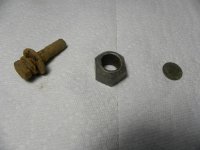
A scene from Peter Weir's new film The Way Back, which traces the perilous journey of a group of prisoners from the Gulag. Source: Supplied
FOR the 6000 brutalised souls interned in Soviet prison camp 303 on the Arctic fringes of Russia's far east, escape was not deemed viable.
Beyond the immediate obstacles of guards, dogs, razor wire, walls and watchtowers lay the biggest deterrent of all: Siberia. Such things held little sway with Slavomir Rawicz, late of the Polish cavalry. In April 1941, under cover of a pre-dawn blizzard, not only did he lead an improbable breakout from his confines, he determined that his ragged gang of seven escapees -- ill-clad and underprovisioned -- should tackle the hostile wilds head-on. They would march right through it and out of the Soviet Union altogether.
Ensnared in the Soviet liberation of his homeland in September 1939, Lieutenant Rawicz was one of 400,000 Poles swept up by the NKVD, the Soviet secret police. Arrested on a trumped-up charge, effectively for being bourgeois, Rawicz, at 24, was sentenced to 25 years' hard labour. Recapture would convert this tantamount death sentence to an actual one. Lingering on Russian soil was not an option. The shortest passage to freedom lay east: a yomp to the Pacific coast and hope of stowing away on a boat to Japan, still a perilous 2400km slog.
Start of sidebar. Skip to end of sidebar.
End of sidebar. Return to start of sidebar.
Instead, Rawicz made a more radical choice: to follow a route due south, over the frontier into Mongolia, across the Gobi desert, then Tibet, and over the Himalayas to the sanctuary of British India. This 7200km, 18-month journey through some of the most inhospitable terrain on earth has since been celebrated as a benchmark of human indefatigability. After the war, Rawicz settled in the English Midlands. In 1956, his memoir, The Long Walk: The True Story of a Trek to Freedom, became an international bestseller, translated into 30 languages.
"It was in 2007 that I read the book," film director Peter Weir says. "It was my sort of thing. As a kid growing up in the 1950s I read Colditz, The Wooden Horse, Reach for the Sky.
"I had a great interest in Shackleton and endurance and escaped people pressed to their limits. And I was fascinated because it also led me to think about how little I knew about the Gulag system, about the repression under Stalin."
Hollywood had wrestled for more than a half century with how to transpose Rawicz's story to the screen; it was originally optioned by Laurence Harvey as a vehicle for Burt Lancaster. Part of the problem lay in selecting just which aspect of Rawicz's epic to dramatise: the escape itself or, more ambitious, the eventual walk. By focusing on the latter, Weir has finally pulled it off. His film, The Way Back, stars Jim Sturgess as the youthful officer leading his ragtag team of Slavs, including Colin Farrell as an unstable Russian, Valka, and Saoirse Ronan as Irena, a Polish girl they pick up en route, who has run away from a prison farm.
"Be warned," says Weir, "it is devoid of the movie conventions of literal cliffhangers or pursuit by Russian guards. I didn't want to make that kind of film. I wanted to make it about these people."
True to the book, there's even an American, a "Mr Smith" (Ed Harris), one of many Westerners legitimately employed in the Soviet Union in the inter-war period -- in Smith's case, as an engineer constructing the Moscow Metro -- whose status was revised to that of enemy of the people.
Sharing top billing, though, is the backdrop itself; this is the first feature film to be produced by National Geographic. Shot on a moderate budget of $US30 million, the film has Bulgaria standing in for the Asian taiga, with versatile Morocco as most points south of the Trans-Siberian Railway.
"They are avoiding settled areas because of the danger of being turned in," Weir says. "So that made it a film about landscapes and these individuals isolated in them, which is part of their problem."
Man and his environment is a running theme of Weir's work, a keynote of his most famous film, The Truman Show. More often than not he sets his films in the past, lavishing his chosen world with period detail: Victorian gentility in Picnic at Hanging Rock; the Anzac landings in Gallipoli; 1960s Indonesia in The Year of Living Dangerously; or the painstaking re-creation of life on a Nelsonian warship in Master and Commander.
The genial Australian, 66, makes films sparingly, this being only his second release in 12 years. "I don't think it's the only way to make films. In a way I'd prefer to work at a faster rate, but I just have to find something I believe I can bring something to. Sometimes I read a script and say, 'It's a fine script, but anybody can do it.' " The fascination with The Way Back lay with sinking his teeth into the research, poring over the archives, interviewing the handful of Gulag survivors still with us. "It was absorbing. I suppose that's another aspect of choosing a subject; it has to be something that will engross you over what is inevitably going to be a couple of years, minimum."
As a young man, Weir says, he read Alexander Solzhenitsyn's The Gulag Archipelago. It had gone "deeply into the memory banks". It was the writings of this dissident, expelled from the Soviet Union in 1974, that played a huge part in raising Western awareness of the barbarity of the Soviet penal system, something he had explored earlier in One Day in the Life of Ivan Denisovich, propelling him to a Nobel prize.
During the Stalinist era (1922-53), it is estimated that more than 18 million people passed through the Gulag -- the letters are a Russian acronym for Main Camp Administration, an Orwellian repository for reactionary thought criminals as well as a conventional institution for ordinary felons. The camps were scattered across the remote wilderness of the Russian interior. Conservative tallies suggest that three million didn't survive, with many dying on the cattle trucks or enforced death marches just to get there.
Though the Gulag was dismantled post-Stalin, some camps remained until the dying days of the Soviet Union. Until recently, Rawicz's epic narrative, superbly written, was regarded as an essential chronicle of this subject, a significant first-person account.
Only there's a slight problem. A few years after his death in 2004, it was revealed, pretty conclusively, that he had made up his story. He had genuinely been interned in a camp somewhere, but his official records -- or, rather, a lack of them -- pointed to his liberty coming by way of a general amnesty granted to Poles in 1942 as the hard-pressed Soviets sought to raise a Polish division to resist the German advance. Rawicz was probably one of the thousands caught up in a maelstrom of migration in which released Poles were shuttled across the vast wastes by train, many ending up alongside the British armed forces in Persia.
Rather, it is said, Rawicz had done a bit of a Marco Polo, appropriating the lives of others -- most specifically the experience of a Pole named Witold Glinski, now an octogenarian living in Hayle, Cornwall, who came forward last year. "I didn't even know about him [Glinski] until I was well under way," Weir says, sighing. "I'd kind of been burnt by this in a way, by this controversy." The Way Back, he points out, is inspired by Rawicz's book, rather than based on it (Sturgess plays a character called Janusz), and it comes with a dedication to all those who made it out of the camps and out of the wilds. "Yes, I fictionalised. But it made me very determined that everything in the film would have some provenance, that I wouldn't make up anything that didn't happen."
Indeed, according to Anne Applebaum, who won a Pulitzer prize for her definitive work Gulag: A History, there were certainly others who had made similar treks to freedom: "people who are said to have walked across Siberia and into India, and who later wrote memoirs; or across into Afghanistan". Some even resorted to cannibalism, which is hinted at in Weir's film.
Applebaum, who is married to Poland's Foreign Minister Radoslaw Sikorski, met Weir several times during his research. Unequivocal in her use of the term slave labour, she points to the fact, in addition to their function as an instrument of terror, the Gulag camps were deliberately designed by Joseph Stalin to power the Soviet economy. More than 28 million people, Gulag inmates or internal exiles, were forcibly engaged in forestry, mining, farming and industry. Whole modern cities, such as Norilsk and Vorkuta, sprang from the toils of those who were worked to death. Applebaum still feels uneasy when she sees the hammer-and-sickle insignia on Western fashion clothing. "You wouldn't wear a swastika, would you?"
Unlike the precision extermination machine created by the Nazis, the Russian set-up was never designed as such. Instead, it was a chaotic organisation, leaving little photographic evidence and with the full archives only recently made available.
There's also good old Western guilt, the lingering discomfort over the unholy wartime alliance of the US and Britain with "Uncle Joe".
"It's awkward to say that we destroyed one genocidal dictator with the help of another," Applebaum says. "It was uncomfortable to condemn the Soviet Union in the same language as the Nazis." In film terms, the "Soviet holocaust" still awaits its Schindler's List, whereas the historical and literary worlds have begun to address the fact "Hitler and Stalin committed the same kinds of crimes in the same place, often to the same people: the Poles, the Ukrainians, the Balts", Applebaum says. "It hasn't filtered down to popular culture yet, and, of course, I'm hoping Peter's film will help that."
Weir, meanwhile, mulls over his next project, delving into his "bottom drawer" of screenplays and wondering what's going to keep him sufficiently captivated. One thing it won't be, as many had hoped, is another Patrick O'Brian adaptation. Unless, he jokes, they can furnish him with a novel that is more land-based. "I sometimes walk into a mate's place," he says. "He's one of those people who's always working on cars -- he has this garage with several vehicles in bits and pieces on the floor -- and I think, God, I've got scripts like that."
Time isn't necessarily on his side, he adds. "You know, I have to be realistic. There's a clock ticking somewhere. But I'm sort of curious to get back to work and not make the next interval so long."






